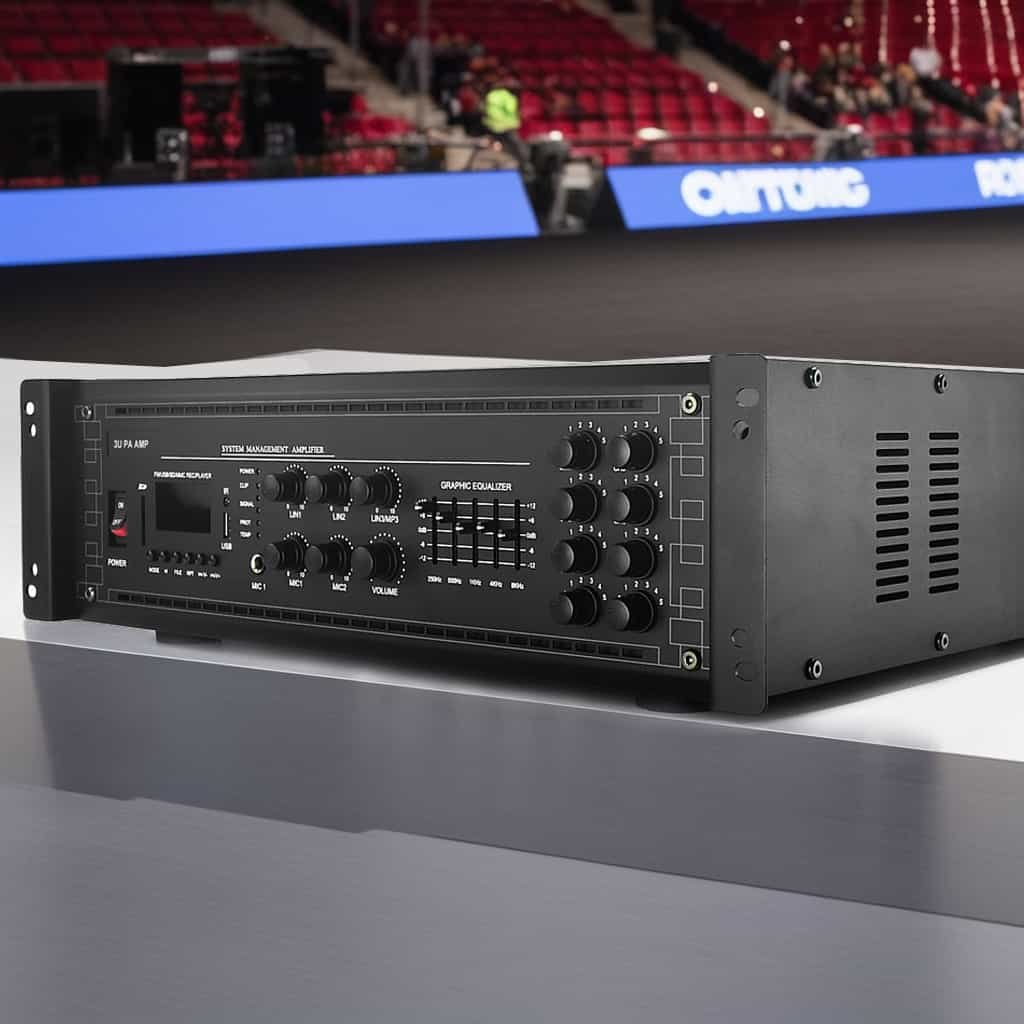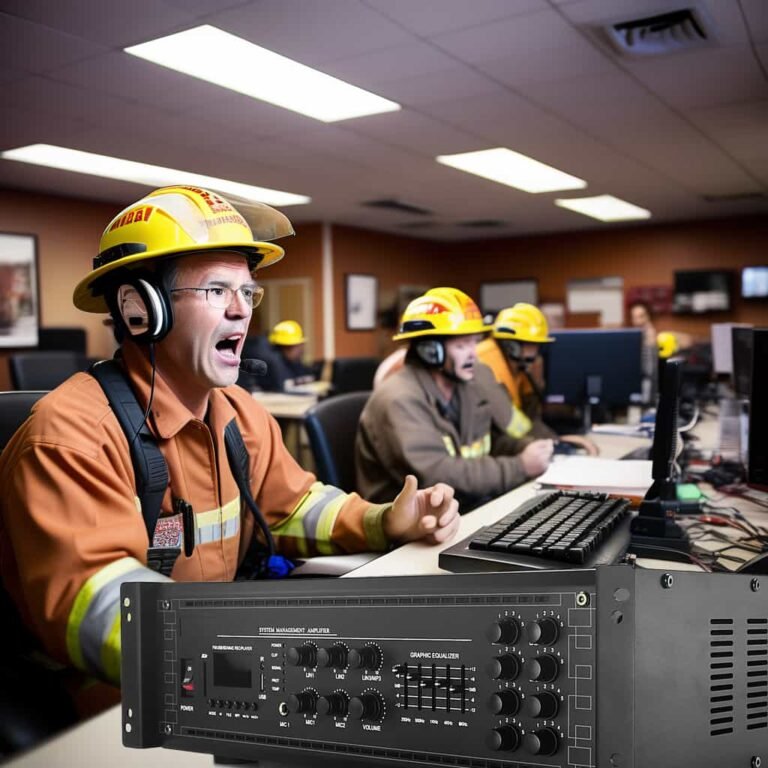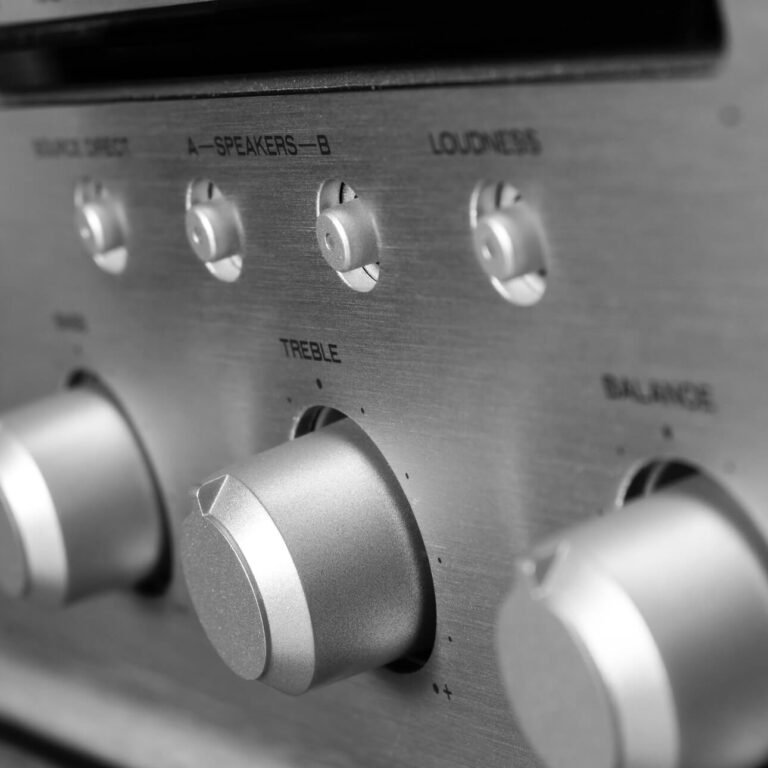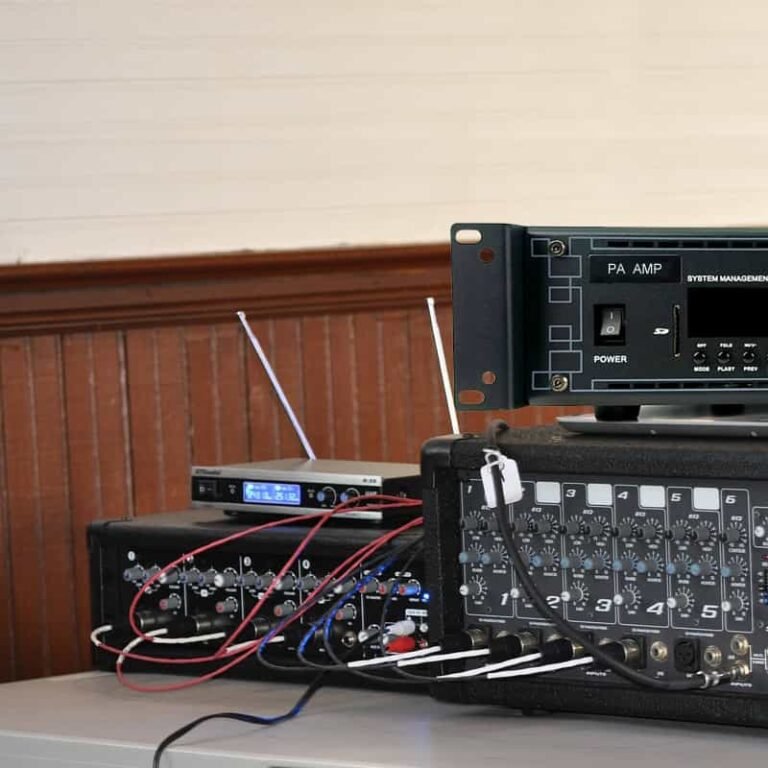Public broadcasting audio amplifiers are essential components of public address (PA) systems that are widely used in events, institutions, and other settings. These amplifiers are responsible for amplifying and distributing audio signals to speakers, ensuring clear and high-quality sound quality. However, selecting the right amplifier for a given application and achieving maximum efficiency can be challenging.

2000w 8zones PA amplifier
This article will provide an in-depth look at the factors to consider when choosing audio amplifiers for broadcasting purposes. It will also discuss strategies for optimizing their efficiency, as well as the role of amplifiers in a PA system. Additionally, this article will explore the emerging trend of IP audio amplifiers and their potential benefits for broadcasting applications.
Key Takeaways:
- Choosing the right audio amplifier for broadcasting requires consideration of factors like power requirements, impedance matching, and durability
- Efficient amplifiers can save on power consumption and minimize heat dissipation, improving system performance
- IP audio amplifiers leverage network connectivity to simplify installation and management processes
- Amplifiers play a critical role in boosting audio signals for delivery to speakers in a PA system
- Best practices for efficient amplification in broadcasting include proper gain staging, speaker placement, and system calibration
Understanding Audio Amplifiers for Public Broadcasting
When it comes to broadcasting audio equipment, audio amplifiers are a crucial element of a public address (PA) system. They boost the signal from audio sources such as microphones and music players and deliver it to the speakers. This amplification is vital in ensuring sound is clearly heard by the intended audience.
There are several different types of audio amplifiers commonly used in broadcasting applications, including:
- Class A amplifiers – These are the simplest and have the best sound quality, but are not very efficient and generate a lot of heat.
- Class B amplifiers – These are more efficient than Class A amplifiers, but have a higher distortion level and require a larger audio signal.
- Class AB amplifiers – These are a combination of Class A and Class B amplifiers, providing a good balance between efficiency and sound quality.
- Class D amplifiers – These are the newest type of audio amplifier and are the most efficient. They use a switching technology to regulate the output, resulting in less heat and power consumption.
When selecting an audio amplifier for public broadcasting, it’s important to consider factors such as power requirements and impedance matching. Different speakers may require varying wattage amplifiers to reach their maximum output.
Sony’s TA-ZH1ES Amplifier System is an example of a high-end audio amplifier that can be used for public audio amplification. This amplifier system can provide 100 watts per channel and has a built-in DAC (digital-to-analog converter) for improved audio quality.
Key Factors for Selecting Amplifiers for Public Broadcasting
Choosing the right amplifier for a public broadcasting system is crucial for achieving optimal sound quality, reliability, and durability. When selecting a professional audio amplifier, broadcasters need to consider several important factors:
| Factor | Importance |
| Power requirements | Amplifier power must match the loudspeakers and the application, providing enough power to achieve the desired sound level without overdriving or damaging the components. |
| Impedance matching | To ensure efficient power transfer, the amplifier’s output impedance must match the loudspeakers’ input impedance, avoiding power loss and distortion. |
| Amplifier specifications | The amplifier’s specifications, such as frequency response, distortion, signal-to-noise ratio, and damping factor, must meet the system’s requirements and standards. |
| Reliability and durability | The amplifier must be designed and built to withstand the rigors of professional use, with rugged construction, high-quality components, and ample cooling. |
Considering these factors can help broadcasters select the right broadcasting amplification device for their public address amplifier system. By choosing a high-quality, professional audio amplifier, broadcasters can enhance the sound quality of their broadcasts and ensure reliable, efficient, and long-lasting operation.
Maximizing Efficiency in Audio Amplifiers for Public Address Systems
Efficiency is a key consideration when selecting audio amplifiers for broadcasting applications. Used in public address systems, audio amplifiers are responsible for receiving low-level audio signals and amplifying them to suitable levels for speakers. Inefficiencies in amplifiers can result in increased power consumption, heat generation, and can compromise the overall system performance.
Why is amplifier efficiency important in public address systems?
Firstly, efficient amplifiers mitigate the risk of thermal stress. As power is dissipated during amplifier operation, it generates heat. If heat is not dissipated adequately, it can damage the amplifier and lead to a reduced lifespan. Secondly, efficient amplifiers consume less power and can result in cost savings on energy bills. Thirdly, efficient amplifiers can provide better sound quality by minimizing distortion and noise.
What are some strategies for maximizing amplifier efficiency in public address systems?
There are several strategies for maximizing amplifier efficiency in public address systems. One method is to implement Class D amplification, which provides better efficiency than traditional Class AB amplifiers by using a switching transistor to reduce power wastage. Power management techniques such as dynamic power output adjustment can also be used to optimize amplifier performance while minimizing power consumption. In addition, selecting an amplifier with suitable specifications and capabilities, matched to the system’s requirements, can help to ensure maximum efficiency.
| Benefits of Efficient Audio Amplifiers | Strategies for Maximizing Amplifier Efficiency |
| Reduced power consumption | Implementing Class D amplification |
| Less heat generation | Using dynamic power output adjustment |
| Better sound quality with less distortion and noise | Matching amplifier specifications with system requirements |
| Cost savings on energy bills |
By following these strategies, broadcasters can maximize the efficiency of their audio amplifiers in public address systems, leading to cost savings, better sound quality, and increased equipment lifespan.
IP Audio Amplifiers for Public Broadcasting
The latest trend in public broadcasting audio equipment is the emergence of IP audio amplifiers. These devices are designed to leverage network connectivity to streamline the installation, control, and management processes of public address systems. By using an IP network, broadcasters can take advantage of digital audio distribution, remote control, and real-time monitoring of amplifier status.
One of the main advantages of IP audio amplifiers is their scalability. By using a network-based approach, amplifiers can easily be added or removed from the system without the need for extra cabling or physical connections. This makes it easy to create a distributed audio system across multiple locations and ensures that the system can be easily expanded or reconfigured as needed.
However, there are some considerations to keep in mind when using IP audio amplifiers. Because these amplifiers rely on network connectivity, they are vulnerable to issues such as network congestion or connectivity interruptions. Therefore, it’s important to ensure that the network infrastructure is robust enough to support the demands of the audio system.
In summary, IP audio amplifiers offer a convenient and scalable solution for public broadcasting applications. By leveraging network connectivity, broadcasters can simplify installation and management processes while still achieving high-quality sound amplification.
The Role of Amplifiers in a PA System
In a public address (PA) system, amplifiers play a crucial role in ensuring the delivery of clear, high-quality sound. PA systems are typically used in large areas, such as schools, airports, and sports stadiums, where it is necessary to broadcast audio messages to a large number of people.
Amplifiers are responsible for boosting the signal from audio sources such as microphones, CD players, and digital audio workstations, then delivering it to speakers. The amplifiers’ power output must match the speakers’ rated power to ensure optimal performance and prevent distortion.
The correct selection of an amplifier depends on the specific requirements of the PA system, which may vary depending on factors such as the size of the area to be covered, the number and placement of speakers, and the types of audio sources used.
Whether it’s a simple one-room setup or a complex multi-zone installation, choosing the appropriate amplifier is vital to achieving a successful PA system. A professional audio amplifier, such as a PA amp, pa amplifier or public address amplifier, correctly matched with the requirements and configurations of the audio equipment system is the backbone of any efficient and reliable PA system.
Sound Amplifier Selection for Broadcasting
Choosing the right sound amplifier is crucial for delivering high-quality audio in broadcasting applications. The selection process involves several considerations such as power output, signal routing, impedance matching, and the need for balanced audio connections.
When selecting an amplifier for public broadcasting, it is important to choose a device with sufficient power output to ensure clear and crisp audio delivery. The amplifier should also feature flexible signal routing options to allow for easy integration with other broadcasting equipment.
Amplifiers designed for public address systems are commonly used in broadcasting applications due to their ability to handle multiple inputs and outputs. These devices are often equipped with impedance matching features that ensure proper power transfer between the amplifier and the speakers.
The need for a balanced audio connection cannot be overstated when it comes to broadcasting. Balanced audio connections help eliminate noise and interference in the audio signal, resulting in a clear and clean output. Amplifiers with balanced audio inputs and outputs are an excellent choice for broadcasting applications.
Overall, the key to selecting the right sound amplifier for broadcasting is to choose an amplifier that can effectively handle the demands of live broadcasts, while also providing clear and crisp audio output.
Best Practices for Efficient Amplification in Public Broadcasting
Optimizing the efficiency of audio amplifiers is crucial for delivering high-quality sound in public broadcasting applications. By following best practices for gain staging, speaker placement, signal processing, and system calibration, broadcasters can achieve efficient amplification and improve the overall sound quality of their broadcasts.
Proper gain staging
Proper gain staging involves balancing the input and output levels of audio signals to avoid distortion and noise. It is important to set the gain levels of each amplifier in the signal chain correctly and avoid overdriving the amplifier. The use of powerful and professional audio amplifiers, such as those from brands like Dynacord or QSC, can ensure proper gain staging and avoid audio compromise.
Speaker placement
The proper placement of speakers is key to achieving the optimal sound coverage and clarity in a public address system. It is essential to place the speakers in appropriate places to avoid sound reflections, echoes, and comb filtering. Using the right broadcasting amplification devices, like JBL speakers, can also help achieve the perfect speaker placement.
Signal processing
Signal processing involves the application of external effects to the sound signal to shape and enhance the sound. The use of digital signal processors (DSP) can help optimize the sound and compensate for any irregularities in the room acoustics. Audio amplifier systems with built-in DSP, such as those from brands like Yamaha or Behringer, can simplify the signal processing process.
System calibration
Proper system calibration involves fine-tuning individual system components to achieve optimal performance. This includes the use of sound measurement tools such as sound level meters, frequency analyzers, and room acoustic analyzers, to optimize the speaker placement, gain settings, and equalization of the system for the best results.
Conclusion
In summary, optimizing the efficiency of audio amplifiers is crucial for delivering high-quality sound in public broadcasting applications. Selecting the appropriate amplifier for a given PA system configuration is key to achieving maximum efficiency. Factors such as power requirements, impedance matching, and amplifier specifications must be carefully considered.
Efficient amplifiers can help reduce power consumption and heat dissipation, leading to improved system performance. Strategies like Class D amplification and power management can make a significant impact in this regard. IP audio amplifiers are also emerging as a viable option in public broadcasting, leveraging network connectivity to streamline installation and management processes.
When selecting amplifiers for broadcasting applications, considerations such as power output, signal routing, impedance matching, and balanced audio connections are important. Best practices such as proper gain staging, speaker placement, signal processing, and system calibration can help further optimize amplifier efficiency.
Overall, achieving efficient and effective amplification in public broadcasting requires careful consideration of system requirements, amplifier specifications, and best practices. By following these guidelines, broadcasters can ensure they are delivering high-quality sound to their audiences with the help of a reliable and capable public address audio amplifier.






